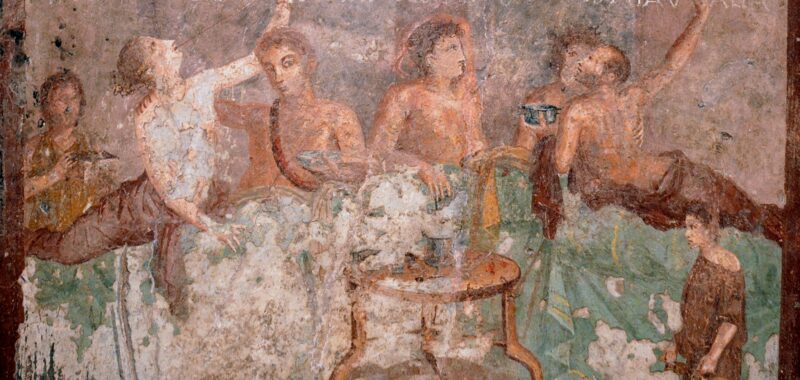Millions of tourists visit the ancient site of Pompeii each year to explore enchanting frescoes, opulent villas, and a seemingly frozen snapshot of a prosperous Roman town. But how did Pompeii come to reach such levels of success and affluence? A new study argues that this was largely due to the labor of enslaved people, who were indispensable to the city’s growth until its demise in 79 CE. The study also provides further evidence that the widespread economic abundance of the early Roman Empire as a whole was predicated less on the singular genius of emperors, generals, or aristocrats, and was instead more heavily reliant on the collective contributions of the millions of enslaved persons laboring across the Mediterranean.
Economic prosperity is often measured today in terms of metrics like Gross Domestic Product (GDP), household income, and income inequality within a given population. And yet, it is only recently that scholars of ancient economic history, like Walter Scheidel, have begun to use more modern economic tools to model the Roman economy and speak in conversation with researchers.
The new article in the journal Past & Present by ancient historian Seth Bernard at the University of Toronto applies many of these modern economic metrics and tools to the ancient world in order to model and then calculate the impact of slavery on the local economy of Roman Pompeii. In the study, Bernard uses statistical and quantitative analyses to statistically argue that enslaved labor was not only a part of Pompeii’s economy, but also the primary source of its prosperity.
From economists to popular media, the prosperity of the Roman Empire during the early imperial period (31 BCE–180 CE) is most often attributed to the large-scale growth in secure trade, stability, and commercial exchange during the period of peace called the Pax Romana. And yet, as Bernard points out, a focus on market expansion and models of long-distance trade or surpluses does not factor in the immense amount of labor contributed by enslaved persons during this period, which in turn allowed for such expansions and surpluses. Around 20% of the population of areas like the Italic peninsula was enslaved, reaching as high as 30% in cities such as Pompeii. In Pompeii and other urban areas, enslaved Romans did everything from spinning pottery and laundering clothes to working in the city’s many brothels.
A conservative estimate for the urban population of Pompeii is 15,000 people, although it may have been as high as 30,000 people, including nearby rural areas. Low estimates would then put the number of enslaved persons at around 3,000 to 4,500 inside the city walls. As Bernard indicates in his economic modeling, there was extreme economic inequality within the city that greatly benefited enslavers. Ultimately, this enslaved population was “responsible for half or even more than half of Pompeii’s economy.” Quantifying the specific monetary contributions of enslaved persons as a whole then provides a numerical means for indicating how they elevated the Roman economy. It also underscores that, as Bernard states, “Slave owning probably formed the largest single income source for the urban economy [within Pompeii].” Using economic modeling, Bernard provides solid evidence that the income that flowed to enslavers through the exploitation of enslaved people was what made Pompeii, and much of the Roman Empire, so economically powerful.
Bernard’s study works in tandem with several other findings in recent years, which have renewed scholarly focus on not only the lives but also the contributions of enslaved people at Pompeii. Excavations since 2020 have uncovered what appear to be the sleeping quarters and bed of an enslaved person and a bakery prison where enslaved workers and donkeys were likely confined. Recent museum exhibitions have focused on non-elites within Pompeii, particularly artisans, enslaved persons, and formerly enslaved individuals known as “freedpersons.” In 2024, archaeologist Silvia Martina Bertesago and Archaeological Park of Pompeii Director General Gabriel Zuchtriegel published a catalog to accompany the exhibition L’altra Pompei – Vite comuni all’ombra del Vesuvio (The Other Pompeii: Ordinary Lives in the Shadow of Vesuvius), which ran at Pompeii from December 2023 to January 2025. This show, in particular, acts as a reminder that changing public dialogue around slavery requires both accessible academic research and public outreach through spaces like museums and archaeological sites.

The push to include enslaved persons in the larger historical narrative of the Roman Empire is ongoing. In his article, Bernard notes the importance of understanding the contributions of enslaved labor to shifting this well-worn story of Roman history in general and modifying more recent moves to write the macroeconomic history of the Mediterranean empire. “Recentering slave labour in the economic history of a paradigmatic Roman city such as Pompeii offers potential to address recent criticism that Roman historians fail to include ‘lives of working people as a major component of economic history,’” he writes.
The names of the millions of invisible workers in Pompeii and elsewhere throughout the Mediterranean have been largely lost to history. However, ancient economic and labor historians like Bernard, Dan-El Padilla Peralta, Sarah Levin-Richardson, Miko Flohr, and many others are working to demonstrate that both the individual lives and the economic contributions of enslaved people are essential to rewriting the narrative of the Roman Empire for the public. Bookshelves across the world are populated by volumes that focus only on the one percent of Roman men who ruled the empire as Caesars and Emperors during the alleged tranquility of the Pax Romana. But it was the violent profitability of slavery as an exploitative labor system that allowed for Rome to prosper in terms of the way that most wealthy Americans still measure “success”: money.

